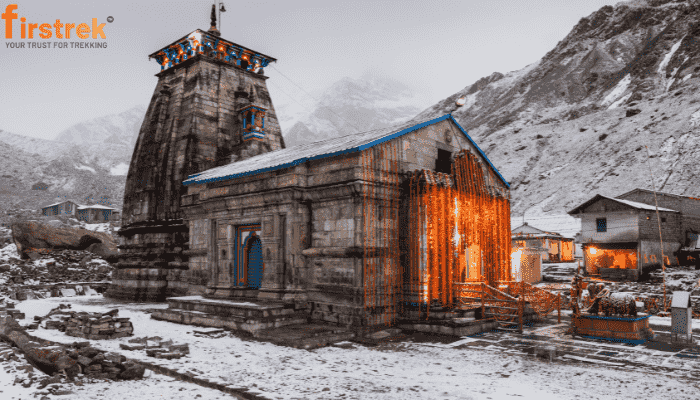
Kedarnath Weather Updates, Today, This Week & Next 3 Weeks
Kedarnath Dham, situated in the serene Garhwal Himalayas of Uttarakhand, India, stands as a pinnacle of spiritual devotion and natural beauty. At an altitude of approximately 3,583 meters (11,755 feet), this ancient pilgrimage site attracts thousands of devotees and tourists seeking solace and tranquility amidst the majestic Himalayan peaks. One of the critical factors influencing the pilgrimage experience here is the ever-changing weather conditions. In this extensive guide, we explore in-depth insights into the Kedarnath Weather Updates, ensuring pilgrims and travellers are well-informed about their journey.
Understanding Kedarnath Dham Weather Patterns

Summary of Geography and Climate
Kedarnath Dham’s geographical location in the Himalayas exposes it to unique weather patterns. The region experiences a subarctic climate due to its high altitude, characterized by cold winters and mild summers. Monsoons bring heavy rainfall from July to September, while winters, from November to February, see heavy snowfall, often leading to the temporary closure of the pilgrimage routes.
The importance of weather updates
Accurate and timely weather updates are crucial for visitors to Kedarnath Dham. They ensure safety, facilitate better planning, and enhance the overall pilgrimage experience. Pilgrims must be prepared for varying conditions, from clear skies to sudden snowstorms, which can impact travel and outdoor activities.

Current Weather Conditions
Today’s Kedarnath Dham Weather
As of the latest update, Kedarnath Dham is experiencing pleasant weather with clear skies and a daytime temperature of 15 °C. This makes it ideal for temple visits and exploring the scenic surroundings without weather-related disruptions.
Detailed Daily Updates
Tomorrow’s Forecast
Tomorrow’s weather forecast predicts sunny conditions throughout the day, with temperatures expected to reach 18°C by midday. Pilgrims can expect clear views of the Himalayan peaks, enhancing their spiritual experience.
Weekly Weather Forecast

Overview of the Week Ahead
Are you planning your visit for the upcoming week? Here’s what you can expect in terms of Kedarnath weather:
Monday: Sunny skies with temperatures peaking at 14 °C.
Tuesday: partly cloudy in the morning, clearing up by afternoon. Temperatures around 15 °C.
Wednesday: Mostly sunny with a gentle breeze, temperatures up to 15 °C.
Thursday: Clear skies persisting throughout the day, temperatures stable at 15 °C.
Friday: mix of sun and clouds, temperatures ranging from 15°C.
Saturday: Sunny intervals with mild temperatures around 14 °C.
Sunday: Similar conditions as Saturday, perfect for outdoor activities and spiritual reflections.
Long-Term Weather Outlook
Next 3 Weeks Forecast
Looking beyond the immediate week, the long-term Kedarnath weather outlook for Kedarnath Dham remains promising:
Second Week: Continued sunny weather with temperatures averaging 15°C to 18°C during the daytime.
Third Week: Clear skies are anticipated, with temperatures ranging between 15°C and 20°C.
Kedarnath Weather Safety Tips for Visitors
Essential Tips for Safety
Ensuring safety amidst varying weather conditions is paramount for pilgrims visiting Kedarnath Dham. Here are some essential tips:
Stay informed: Regularly check updated weather forecasts and advisories.
Dress Appropriately: Layer clothing to adjust to temperature changes throughout the day.
Stay Hydrated: Drink plenty of water to avoid dehydration at high altitudes.
Emergency Preparedness: Carry essential medications and emergency contacts at all times.
Staying informed about Kedarnath weather updates is essential for a safe and enriching pilgrimage experience. Whether you’re planning a visit today, this week, or in the upcoming weeks, our detailed forecasts and safety tips ensure you can make the most of your journey amidst the awe-inspiring Himalayan landscape.
The best time to visit Kedarnath

Visiting this sacred pilgrimage site demands careful consideration of the seasonal nuances that define its charm throughout the year. Whether you’re planning a spiritual journey, a trekking adventure, or simply seeking to immerse yourself in the tranquillity of the Himalayas, understanding the Kedarnath weather is crucial for an enriching experience.
| Seasons of Travel | Minimum and Maximum Temperatures | Time of year |
| April–June | 15 to 30 degrees | Summer |
| July–August | 12 to 27 degrees | Monsoon |
| September–October | 0 to 15 degrees | Winter |
Summer in Kedarnath: Embracing Tranquil Beauty
Summer, spanning from April to June, emerges as one of the most preferred seasons for pilgrims and travellers alike to embark on a journey to Kedarnath. The Kedarnath weather during this period is mild and inviting, with temperatures ranging from a comfortable 15°C to 25°C. Clear skies and pleasant weather conditions prevail, creating an ideal setting for exploring the temple, trekking along picturesque trails, and basking in the awe-inspiring vistas of the Himalayan peaks.
Transitioning from the hustle and bustle of daily life to the serene ambience of Kedarnath during the summer is a rejuvenating experience. The temple and surrounding areas are accessible, allowing devotees to participate in rituals and experience the spiritual energy that permeates this sacred site. Moreover, the lush greenery and blooming flora add a touch of vibrancy to the landscape, enhancing the overall allure of a visit during this season.
Monsoon: Navigating Through Nature’s Bounty and Challenges
As the monsoon season descends upon Kedarnath weather from July to September, the landscape undergoes a dramatic transformation. The region receives heavy rainfall, which rejuvenates the flora and replenishes the mountain streams and waterfalls. However, travelling during the monsoon poses significant challenges due to the risk of landslides, slippery paths, and occasional road closures.
Despite the adversities, adventurous souls may find the monsoon season intriguing for its ethereal beauty and the opportunity to witness nature’s raw power in the Himalayas. The mist-covered mountains and cascading waterfalls create a mystical ambience, offering a unique perspective for those who dare to venture amidst the rain-drenched landscapes. However, for most pilgrims seeking a seamless journey to Kedarnath, it’s advisable to exercise caution and plan visits outside of the monsoon months to ensure safety and convenience.
Winter: Embracing Serenity Amidst the Snow-Covered Peaks
Winter casts a serene and mystical veil over Kedarnath, transforming it into a tranquil sanctuary amidst the snow-clad Himalayan peaks. From December to March, the region experiences sub-zero temperatures and heavy snowfall, which blankets the landscape in a pristine white cloak. The temple at Kedarnath remains closed during this period due to the harsh weather conditions, making it inaccessible for regular pilgrimages.
For avid trekkers and adventure enthusiasts, winter offers a unique opportunity to explore the snow-covered trails and experience the unbridled beauty of Kedarnath in its most pristine form. However, venturing into these high-altitude regions requires specialized gear, experience in cold-weather trekking, and the utmost caution to navigate the icy terrain safely. Winter thus beckons those seeking solitude and a deep connection with nature amidst the secluded Himalayan wilderness.
Kedarnath Weather: A Month-by-Month Guide
Knowing the Kedarnath weather at all times of the year is crucial to organizing a secure and pleasurable trip to this revered Himalayan location. Every month has different weather conditions that can greatly affect your trip experience, from the cold, snowy winters of January and February to the warm, sunny days of late spring and early autumn. Knowing the seasonal changes helps pilgrims and visitors select the ideal time to visit so they can be ready for the trek ahead. Understanding the specific weather patterns will help you make the most of your trip to Kedarnath, whether your goal is to experience the quiet beauty of fall, the lively spirituality of summer, or the serene serenity of winter with snow.
Which season is ideal for travelling to Kedarnath?
Travelling to Kedarnath is most enjoyable in May and June, September, and October. These times are perfect for pilgrimages and sightseeing since they have nice weather, clear skies, and accessible trekking routes.
What can I expect in Kedarnath during the monsoon season?
Monsoon season in Kedarnath (July to September) brings heavy rainfall, which can lead to landslides and slippery trekking paths. The temperatures range between 10°C and 17°C. While the scenery is lush and green, travel during this period can be risky.
How cold does it get in Kedarnath?
Kedarnath weather can get very cold, especially in the winter months. Temperatures can drop as low as -8 °C in January. Even during the summer, nighttime temperatures can fall significantly, so it’s important to be prepared with warm clothing.
How does the weather affect the accessibility of Kedarnath?
The Kedarnath weather greatly impacts its accessibility. Heavy snowfall in winter closes the temple and makes the area accessible only to experienced trekkers. Monsoon rains can cause landslides and slippery paths, making travel risky. Summer and autumn offer the best conditions for safe travel and trekking.
How does the Kedarnath weather affect the trekking conditions?
The Kedarnath weather greatly influences trekking conditions. Clear and mild weather in spring and autumn provides ideal trekking conditions, while heavy snow in winter and rain in monsoon make trekking difficult and sometimes dangerous.